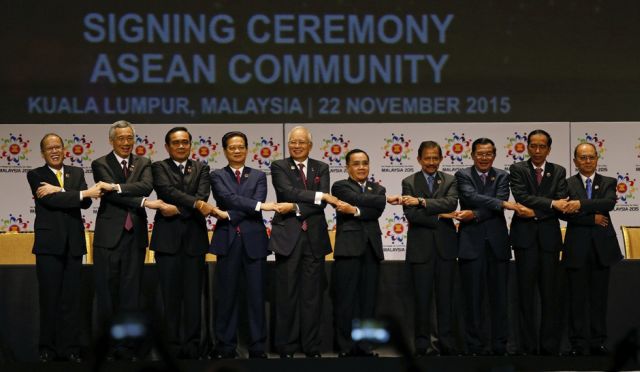
ASEAN Leaders, including Philippine President Benigno Aquino III (left), join hands as they pose for photographers during the signing ceremony of the 2015 Kuala Lumpur Declaration on the Establishment of the Association of Southeast Asian Nations (Asean) Economic Community in Kuala Lumpur, Malaysia on Nov. 22, 2015. (AP PHOTO)
Local businesses better be prepared to compete under an integrated regional economy. The Asean Economic Community (AEC) was formally created during the 27th Asean Summit on November 22 in Kuala Lumpur, creating a huge single market of more than 630 million consumers.
Economic integration in the region was formalized even as Southeast Asia economies, the Philippines included, have continued to feel the impact of China’s economic troubles. Share prices have remained volatile and the peso has continued to depreciate against a strong US dollar.
Despite the market volatility, the Gaisano-led Metro Retail Stores Group, Inc. proceeded to list on the Philippine Stock Exchange. It was the first listing for a Cebu-based company in almost a decade.
The year 2015 was big for the local retail industry. Aside from Metro Retail going public, two huge malls and a few community malls and commercial strips opened in Metro Cebu this year. These new shopping and lifestyle destinations are seen to enhance tourism.
Further boosting the local tourism industry was the launching of the new Cebu brand, deemed as timely considering that the Department of Tourism has declared 2016 as Visit the Philippines Again Year.
INTEGRATION
Leaders of the 10 member-nations of the Association of Southeast Asian Nations (Asean) formally created the Asean Economic Community (AEC) to allow free flow of goods, services, capital and human resources across the region by December 31, 2015.
With over 630 million people and a combined gross domestic product of $2.4 trillion in 2013, Southeast Asia is one of the largest markets and economies in the world.
The road to a single Asean market and production base has long started, with the more advanced members gradually bringing down tariffs as well as non-tariff barriers. The four poorer economies – Cambodia, Laos, Myanmar and Vietnam – have until 2018 to bring down tariffs.
Economist Fernando Fajardo said local businesses should welcome the competition that the regional integration will bring and strive to improve the quality of their products as well as lower their production costs to stay ahead.
The AEC Blueprint 2025 forms part of ASEAN 2025: Forging Ahead Together, which also includes blueprints for political-security and socio-cultural integration.
CHINA EFFECT
The Philippine Stock Exchange index (PSEi) dipped and the peso depreciated, among others, as external headwinds emanating from the Chinese economic slowdown and yuan devaluation drove up risk aversion.
The PSEi closed at 7,002.42 on December 23, losing 228.15 points in the last 12 months. The index ended 2014 at 7,230.57.
The peso has depreciated to P47.22 against the US dollar as of December 23 compared to P44.7 as of end-2014.
The Bangko Sentral ng Pilipinas, however, assured that domestic financial market conditions have remained sound.
The Philippine banking system also continued to be sound and resilient, as indicated by various metrics for capitalization as well as asset growth and quality, the Bangko Sentral added.
Even after the US Federal Reserve adjusted its rates, the Monetary Board maintained key policy rates at 4.0 percent for the overnight borrowing or reverse repurchase (RRP) facility and 6.0 percent for the overnight lending or repurchase (RP) facility. The interest rates on term RRPs, RPs and special deposit accounts (SDA) were also kept steady. The reserve requirement ratios were likewise left unchanged.
Inflation is seen to end the year below the target range of 3.0 percent ± 1 percentage point. The Bangko Sentral said potential upside pressures next year “could come from the impact of prolonged El Niño dry weather conditions on food prices and utility rates as well as pending petitions for power rate adjustments, while downside risks could arise from possible slower-than-expected global economic activity.”
MARKET DEBUT
Despite the volatility in the capital markets, homegrown Metro Retail Stores Group, Inc. went public in November in a bid to improve margins and operating efficiency as well as create value for its investors.
The Gaisano-owned company debuted on the Philippine Stock Exchange, raising P3.6 billion from its initial public offering (IPO) involving 905.4 million common shares at P3.99 apiece. Metro shares, with trading symbol MRSGI, closed at P3.83 on December 23.

Metro Retail Stores Group, Inc. lists on the Philippine Stock Exchange on Nov. 24, 2015. (CDN FILE PHOTO)
The IPO, held 33 years since Metro was established, was the first for a Cebu-based company in about a decade. It was also the first for a Gaisano, an iconic name in Cebu’s retail industry.
Proceeds from the IPO will be used to fund the company’s plan to build 50 to 70 more stores in the next five years.
There are currently 46 Metro stores across its retail formats – department store, supermarket, hypermarket and neighborhood stores.
Metro is the retail arm of Vicsal Development Corp., which was established by couple Victor and Sally Gaisano. Metro is the fourth largest retailer in the country, after SM, Puregold and Robinsons. It is the largest department store and hypermarket operator in the Visayas.
MORE THAN SHOPPING
Two huge malls and a couple of pocket malls opened in Cebu this year, expanding the choices for a shopping and lifestyle destination in Cebu.
SM Seaside City Cebu, the fourth biggest mall in the country and 56th by SM Prime Holdings, Inc., opened at the South Road Properties on November 27. It has a gross floor area of 430,000 square meters and can accommodate more than 400 tenants.
The new mall is also SM’s second so-called lifestyle city after Mall of Asia Complex in Pasay City. A lifestyle city is a mixed-use development that offers retail, residences, offices, hotels and convention centers.
“It’s not anymore just shopping. It’s a way of life. We’re getting people out of their houses to come here and really enjoy life,” SM Prime President Hans T. Sy said during the mall’s opening.
The mall complex will include an arena, an ocean park, an interactive child-friendly park with water features, and a 45-level viewing tower with a panoramic view of Cebu City and a Sky Park designed by Kenneth Cobonpue.
SM Prime is looking at a fourth mall project in Cebu, one of 19 new malls that the company has committed to open in the country by 2018.
About two weeks after SM Seaside opened, Robinsons Land Corp. inaugurated Robinsons Galleria Cebu, its biggest development outside Metro Manila.
Galleria Cebu is Robinsons’ third biggest after Robinsons Manila and Robinsons Galleria Ortigas. It is also Robinsons’ 41st mall in the country.
The mall features regional food outlets such as Sans Rival, Bohol Bee Farm’s The Buzzz Cafe, and The Chocolate Chamber.
Aside from the mall, Galleria will also have a four-star Summit hotel, business process outsourcing (BPO) office spaces, and three condominium buildings.
Aside from the two large malls, pocket developments were also introduced across Metro Cebu this year, namely, Streetscapes in Banilad, CityMall in Consolacion town, City Soho Mall on B. Rodriguez St., and Gaisano Grand in Liloan town.
NEW BRAND
Cebu launched a new brand – Cebu, where the heart sings – in colorful letters with the outline of a Sinulog festival dancer holding aloft a red heart.

Cebu launches new brand – Cebu, where the heart sings – on Nov. 13, 2015. (CDN FILE PHOTO)
The brand is encouraged to be used in all tourism promotional materials about Cebu.
Tetta Baad, chairperson of the Cebu City Tourism Commission, said the brand logo stands for the passion, creativity, warmth and resilience of Cebuanos.
The word Cebu is done in four colors – yellow for warmth and friendship; green for nature and creativity; red for faith and passion; and dark blue for resilience.
The team behind the brand consisted of volunteers as well as representatives of Cebu Chamber of Commerce and Industry (CCCI), Mega Cebu, tourism commissions of Cebu City and Cebu province, Cebu Association of Tour Operators, and GMR-Megawide Cebu Airport Corp.
Disclaimer: The comments uploaded on this site do not necessarily represent or reflect the views of management and owner of Cebudailynews. We reserve the right to exclude comments that we deem to be inconsistent with our editorial standards.
